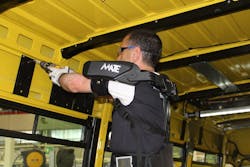With examples ranging from 5G-connected hardhats to augmented reality (AR) headsets, wearable technologies are on the rise in industry. According to market research firm MarketsAndMarkets, the global industrial wearable market is expected to grow from $3.79 billion in 2019 to $8.4 billion by 2027. But wearable technologies can be used for more than simply providing AR-enabled remote assistance. Another rapidly expanding application is the use of wearables that improve ergonomics in industrial settings to reduce the likelihood of employee injuries.
According to ergonomics consultants at national insurance carrier The Hartford, employers pay an aggregate of nearly $1 billion per week in workers' compensation costs. Moreover, nine out of the top 10 most common preventable injuries are linked to musculoskeletal disorders that can be corrected via improved ergonomic practices.
An example of how wearable devices are used to improve worker ergonomics can been seen in the experience of vehicle manufacturer Iveco, which has been using Comau’s wearable exoskeleton called Mate in its Brescia, Italy plant. Here, Mate is used by employees working on the interior construction of minibuses, a task that required they perform many activities while lifting their arms, which can lead to shoulder strain.
“This department features many activities that must be carried out while lifting the arms. A demanding condition in itself, which requires even more attention, considering that the average age of Iveco employees is around 49 years," said Paolo Gozzoli, production manager at Iveco.
After trying out several different exoskeletons, Iveco chose Mate in 2018. According to Gozzoli, two key considerations factored into the decision. First, Iveco needed a device that would assist operators in activities involving the upper limbs without reducing their mobility. Secondly, the device needed to be lightweight, particularly in Brescia’s warm summer climate where excessive heat could be uncomfortable or even dangerous. Mate met both criteria, Gozzoli said.
"I have used the Mate exoskeleton for a few months now, and I must say that I immediately found relief, especially for my shoulders. When mounting the reinforcements in the upper part of the vehicle, I have to keep my arms raised for a long time, often while I’m holding the tools I need to mount the various components," explained Antonio Maccarinelli, team leader for section 1 of the minibus line at Iveco's Brescia plant. "Even though they are all light objects, at the end of my shift I always noticed that this apparently minimal effort took its toll on my body. Now, my shoulders are in an excellent condition. Moreover, I must say that the device is really easy to wear. It’s like carrying a backpack, and just needs a few initial settings to be immediately operational. Adjusting the shoulder straps is also quick and easy, which is really important, because I share Mate with other operators. Each of us has a slightly different build, but we can easily adapt it and feel comfortable.”


